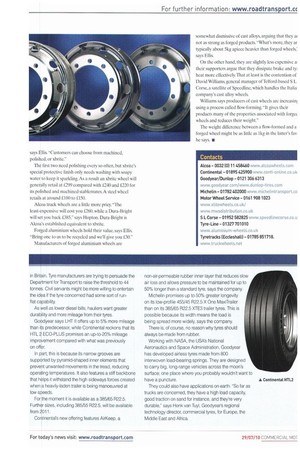TREADING CAREFULLY Tyre manufacturers are also working to reduce the
Page 32

Page 33

If you've noticed an error in this article please click here to report it so we can fix it.
weight of their products without compromising durability. Goodyear, for instance, has cut the weight of its new Marathon Long Haul Trailer II tyre (LHT II) by 7.5kg compared with its LHT+ predecessor.
As with wheels, reducing the weight of tyres boosts payload and cuts diesel usage. Tyremakers are also concentrating on cutting rolling resistance, especially on products destined for long-distance applications, again with fuel saving in mind.
That is certainly the case with the latest crop of trailer tyres.
The new long-distance HTL 2 ECO-PLUS from Continental is said to have up to 15% less rolling resistance than standard trailer tyres, which the manufacturer says translates to fuel savings of up to 5%.
Part of this has been achieved by careful attention to the tread design. The extra-wide shoulders and the broad tread set between four straight circumferential grooves compress the tread pattern as far as possible to the inside of the tyre contact surface.
That, says Continenta#, lessens rolling resistance significantly.
Attention also has to be paid to the tread compound, which often means increasing the use of silica. This, along with a compact tread design offering low energy dissipation, has helped Goodyear reduce LHT ll's rolling resistance.
Goodyear has had LHT Ils on trial at 40 tonnes with Zeller Transporte.
The Austrian operator has been using a set of LHT Ils along with sets of Marathon Long Haul Steer II steer-axle tyres and Marathon Long Haul Drive II drive-axle tyres on distance work. It reports that diesel usage dropped 3.7% compared with the return achieved by a 40-tonner running in similar conditions on the same work. Both trucks were fitted with the same types of driveand steer-axle tyre, but one trailer wore LHT+ boots.
Due for release on this side of the Channel in the autumn, LHT II will be sold in 385/55 R22.5, 385/65 R22.5 and 435/50 R19.5 sizes for starters.
One way of cutting rolling resistance by around 20% would be to switch to super-single drive-axle tyres. Unfortunately, these are only permitted at up to 41 tonnes
in Britain. Tyre manufacturers are trying to persuade the Department for Transport to raise the threshold to 44 tonnes. Civil servants might be more willing to entertain the idea if the tyre concerned had some sort of runflat capability.
As well as lower diesel bills, hauliers want greater durability and more mileage from their tyres.
GoCidyear says LHT II offers up to 5% more mileage than its predecessor, while Continental reckons that its HTL 2 ECO-PLUS promises an up-to-20% mileage improvement compared with what was previously on offer.
In part, this is because its narrow grooves are supported by pyramid-shaped inner elements that prevent unwanted movements in the tread, reducing operating temperatures. It also features a stiff backbone that helps it withstand the high sideways forces created when a heavily-laden trailer is being manoeuvred at low speeds.
For the moment it is available as a 385/65 R22.5. Further sizes, including 385/55 R22.5, will be available from 011.
Continental's new offering features AirKeep, a
non-air-permeable rubber inner layer that reduces slow air foss and allows pressure to be maintained for up to 50% longer than a standard tyre, says the company.
Michelin promises up to 50% greater longevity on its low-profile 455/45 R22.5 X One MaxiTrailer than on its 385/65 R22.5 XTE3 trailer tyres. This is possible because its width means the load is being spread more widely, says the company.
There is, of course, no reason why tyres should always be made from rubber.
Working with NASA, the USA's National Aeronautics and Space Administration, Goodyear has developed airless tyres made from 800 interwoven load-bearing springs. They are designed to carry big, long-range vehicles across the moon's surface; one place where you probably wouldn't want to have a puncture.
They could also have applications on earth. "So far as trucks are concerned, they have a high load capacity, good traction on sand for instance, and they're very durable," says Honk van Tuyi, Goodyear's regional technology director, commercial tyres, for Europe, the Middle East and Africa.




























































































































